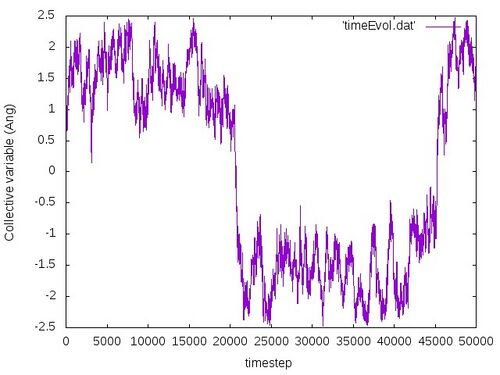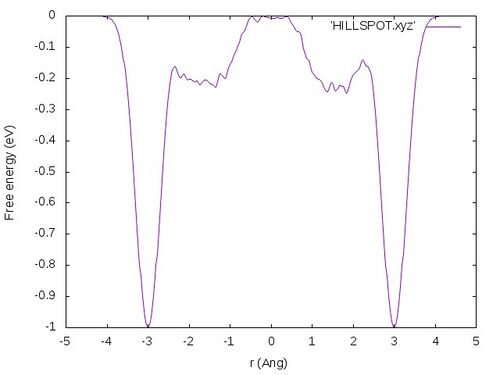Nuclephile Substitution CH3Cl - mMD2
Task
In this example the nucleophile substitution of a Cl- by another Cl- in CH3Cl via meta dynamics is correctly simulated by using extra "repulsive potential walls."
Input
POSCAR
1.00000000000000
12.0000000000000000 0.0000000000000000 0.0000000000000000
0.0000000000000000 12.0000000000000000 0.0000000000000000
0.0000000000000000 0.0000000000000000 12.0000000000000000
1 3 2
cart
5.91331371 7.11364924 5.78037960
5.81982231 8.15982106 5.46969017
4.92222130 6.65954232 5.88978969
6.47810398 7.03808479 6.71586385
4.32824726 8.75151396 7.80743202
6.84157897 6.18713289 4.46842049
KPOINTS
Automatic 0 Gamma 1 1 1 0. 0. 0.
- For isolated atoms and molecules interactions between periodic images are negligible (in sufficiently large cells) hence no Brillouin zone sampling is necessary.
INCAR
PREC=Low EDIFF=1e-6 LWAVE=.FALSE. LCHARG=.FALSE. NELECT=22 NELMIN=4 LREAL=.FALSE. ALGO=VeryFast ISMEAR=-1 SIGMA=0.0516 ############################# MD setting ##################################### IBRION=0 # MD simulation NSW=1000 # number of steps POTIM=1 # integration step TEBEG=600 # simulation temperature MDALGO=11 # metaDynamics with Andersen thermostat ANDERSEN_PROB=0.10 # collision probability HILLS_BIN=50 # update the time-dependent bias # potential every 50 steps HILLS_H=0.005 # height of the Gaussian HILLS_W=0.05 # width of the Gaussian ##############################################################################
- Same INCAR file as in the previous example (Nuclephile Substitution CH3Cl - mMD).
ICONST
R 1 5 0 R 1 6 0 S 1 -1 5
- This file is the same as in the previous example (Nuclephile Substitution CH3Cl - mMD1).
PENALTYPOT
-3.00000 1.00000 0.30000 3.00000 1.00000 0.30000
Calculation
In principle, meta dynamics always seeks for the path of least resistance. In the case of our model system this corresponds to the dissociation of the vdW complex (which is linked with a lower barrier than the SN2 reaction). In order to avoid this undesired process, an extra bias potential ("repulsive walls") is used whose role is to restrict our sampling to a relevant region (approx. collective variable ). In fact, the positions of walls can be chosen arbitrarily - we only require that the region between the walls contains all the information we are interested in (in this case we want to see free-energy minima for both "reactant" and "product" as well as the "transition state"). In order for the walls to be effective, we also require that they are significantly higher than the expected reaction barrier (otherwise the likelihood to cross the wall during meta dynamics would be higher than that for the barrier). From the potential energy profile (static calculations not reported here) we obtained a reasonable guess for the reaction barrier - it is about 0.4 eV - hence the height for the wall of 1 eV should be sufficient.
Running the calculation
The mass for hydrogen in this example is set 3.016 a.u. corresponding to the tritium isotope. This way larger timesteps can be chosen for the MD (note that the free energy is independent of the masses of atoms).
The bias potential is specified in the PENALTYPOT file.
For practical reasons, we split our (presumably long) meta dynamics calculation into shorter runs of length of 1000 fs (NSW=1000; POTIM=1). At the end of each run the HILLSPOT file (containing bias potential generated in previous run) must be copied to the PENALTYPOT fiel (the input file with bias potential) - this is done automatically in the script run which looks as follows:
#!/bin/bash runvasp="mpirun -np x executable_path" # ensure that this sequence of MD runs is reproducible cp POSCAR.init POSCAR cp INCAR.init INCAR rseed="RANDOM_SEED = 311137787 0 0" echo $rseed >> INCAR i=1 while [ $i -le 50 ] do # start vasp $runvasp # ensure that this sequence of MD runs is reproducible rseed=$(grep RANDOM_SEED REPORT |tail -1) cp INCAR.init INCAR echo $rseed >> INCAR # use bias potential generated in previous mMD run cp HILLSPOT PENALTYPOT # use the last configuration generated in the previous # run as initial configuration for the next run cp CONTCAR POSCAR # backup some important files cp REPORT REPORT.$i cp vasprun.xml vasprun.xml.$i let i=i+1 done
- The user has to adjust the runvasp variable, which holds the command for the executable command.
- Please run this script by typing:
bash ./run
Time evolution of distance
During the simulation, the time evolution of collective variable can be monitored using the script timeEv.sh:
#!/bin/bash
rm timeEvol.dat
i=1
while [ $i -le 1000 ]
do
if test -f REPORT.$i
then
grep fic REPORT.$i |awk '{print $2 }' >>timeEvol.dat
fi
let i=i+1
done
To execute this script type:
bash ./timeEv.sh
This script creates the file timeEvol.dat. To visualize that file execute the following command:
gnuplot -e "set terminal jpeg; set xlabel 'timestep'; set ylabel 'Collective variable (Ang)'; set style data lines; plot 'timeEvol.dat'" > timeEvol.jpg
The plot of the collective variable with respect to the timestep should look similar to this:
If everything goes well, you should observe that the amplitude of oscillations of the collective variable increases (as larger and larger region of configuration space is visited by the meta dynamics) and at some poin the collective variable switches from a positive value (corresponding to reactant) to a negative value (correpsonding to product). At the end of your calculation, you should observe depending on how long you ran the calculation (50 or more ps) one or two crossings of the transition state (where the collective variable is equal to zero).
1D free-energy profile
The current bias potential generated by meta dynamics is written to the HILLSPOT file. A negative image of this potential serves as an approximation of the free-energy profile and it can be visualized using the script calcprofile1D.py:
#!/usr/bin/python
from math import *
def gauss_pot(x,x0,h,w):
en=h*e**(-(x-x0)**2/2.0/w**2)
return en
f=raw_input('File name?\n')
ff=f+'.xyz'
name=raw_input('x1_min x1_max N:\n')
name=name.split()
a0=float(name[0])
a1=float(name[1])
num=int(name[2])
f=open(f,'r')
data=[]
h=[]
w=[]
for line in f.readlines():
line=line.split()
x=[]
if (len(line)>2):
for i in range(len(line)-2):
x.append(float(line[i]))
data.append(x)
h.append(float(line[-2]))
w.append(float(line[-1]))
f.close()
ff=open(ff,'w')
step=(a1-a0)/num
x=a0
for i in range(1,num):
en=0.0
penalty1=0
penalty2=0
x=x+step
for j in range(len(data)):
x0=data[j][0]
en_=gauss_pot(x,x0,h[j],w[j])
en+=en_
ff.write(`x`+'\t'+`-en`+'\n')CH3Cl_mMD1.tgz
ff.close()
This script projects one-dimensional Gaussians defined in the input file (such as PENALTYPOT or HILLSPOT) onto a regular grid of points defined by a user. The user is asked to provide the following data: (a) name of the input file, (b) the initial (x1_min) and the final (x1_max) grid point position, and the number of grid points (M) for the axis corresponding to the collective variable. The result is written in file with extension .xyz.
In our example we will use the following inputs:
Run script:
python calcprofile1D.py
File name?
HILLSPOT
x1_min x1_max N:
-5 5 500
To plot the 1D free energy profile type:
gnuplot -e "set terminal jpeg; set xlabel 'r (Ang)'; set ylabel 'Free energy (eV)'; set style data lines; plot 'HILLSPOT.xyz'" > 1D_free_energy.jpg
The resulting free energy profile should look like the following:


